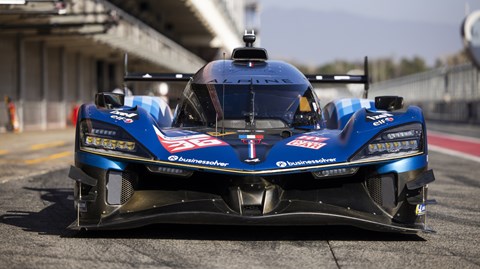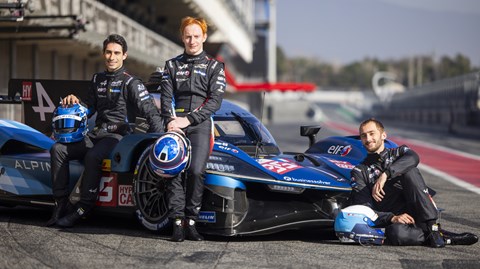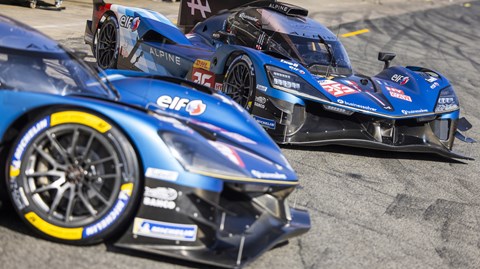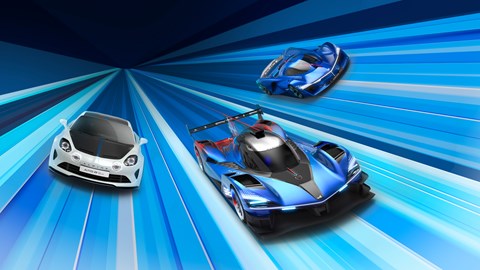► A424 revealed alongside F1 car form
► Will challenge the Hypercar series in 2024
► Powered by a 670bhp turbocharged V6
Yesterday, Alpine revealed its all-new A524 F1 car, but it shared the stage with this; the A524 Hypercar. Now under development for one and a half years, the program has some significant signings under its belt, and forms one side of Alpine’s two-pronged attack into motorsport. It’s only the second OEM to do both the World Endurance Championship and Formula One in parallel: it’s just Ferrari and Alpine for now – but they’ll both be joined by Aston Martin.
At yesterday’s launch the team confirmed it’ll run two cars, and also revealed which drivers will drive which. The #35 car will be driven by Paul-Loup Chatin, Charles Milesi and Ferdinand Habsburg, while the #36 car will be helmed by Nicolas Lapierre and Matthieu Vaxiviere and Mick Schumacher.

Keep reading for everything else you need to know about the Alpine A424.
What else do you need to know?
The new Alpine A424 was unveiled at the 100th running of the 24 Hours of Le Mans, in which the brand will field two cars in the slower LMP2 class. But when this new Hypercar hits the grid in 2024, it’ll compete against some of the fastest cars in the series from the likes of Peugeot, Porsche, Ferrari and Toyota.

Alpine’s Hypercar is built according to LMDh regulations, which allows teams to compete in both the FIA World Endurance Championship and the North American IMSA Sports Car Championship with the same car. Teams can choose from one of four chassis on which to base their racers – and there are some strict regulations governing their aerodynamic performance, weight and power output.
LMDh rules state that Hypercars can’t weigh any less than 1,030kg, their power output is capped at 670bhp and they all must have a 50kW hybrid system. Downforce is strictly regulated, too. Naturally, though, Alpine has min-maxed all these stats in an effort to make the most of the series’ rulebook and ensure the A424 is competitive in the race.
Tell us more about the A424’s mechanicals
LMDh regulations stipulate that, while a Hypercar’s chassis, hybrid system and transmission must be pulled from a pool of standard parts, its engine must be made in-house. The A424’s engine was a collaborative effort between Alpine and the French engineering company Mecachrome. It’s a turbocharged 3.4-litre V6 with an 670bhp and a redline of 9000rpm.
Christophe Chapelain, Alpine’s Hypercar LMDh project chief engineer, says his team will be the only one running a car with this engine configuration on the grid. He also says the A424’s engine drew on the experience gathered by Alpine’s Formula One racing exploits.

‘It must be noted that the synergies with F1 are such that our LMDh software is strongly inspired by F1,’ he said. ‘The F1 cost cap also works in our favour, as it frees up dyno hours in addition to those available at Mecachrome.’ Alpine also borrowed a few of its Formula One engineers to help piece together its Le Mans Hypercar project.
And what about the bodywork?
Racing teams have a little more freedom here. LMDh cars must comply to strict aerodynamic principles but, as long as they meet the rules, their styling can be at the whim of the team’s designers. So, when Alpine was blueprinting the A424 with Oreca (another one of its engineering partners), it tried hard to inject some of its road car DNA into the project.
Chapelain said: ‘From the outset, [Oreca] have been tremendously reactive to our demands whilst providing us with a wealth of information for the engine integration. As for the chassis, it’s the first time they’ve dealt with so much input from car designers. Compromises had to be made, between the desire for design and certain regulatory aspects for example.
‘However, the aerodynamic window leaves enough room to incorporate many ideas whilst converging towards the required windows. We had to reunite two different worlds and the result is magnificent. It shows that everyone has worked in the same direction to make this project successful, not only in terms of style today, but also on track tomorrow.’

To keep weight down, the A424’s bodywork is made entirely from carbon fibre. Its styling also seems to riff off the ideas proposed by Alpine’s hydrogen-powered Alpenglow concept (pictured on the right of the image above) which, in turn, previews the company’s styling language for its next generation of road cars. The A424’s front light bar is remarkably similar to the concept racer, as is the shape of its cockpit and its rear end.
Alongside its new Hypercar, Alpine also unveiled a special edition version of its A110 R sports car at the opening of the 2023 Le Mans race. It celebrates the 100th anniversary of the iconic endurance race and will be limited to just 100 examples worldwide.